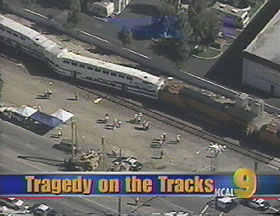
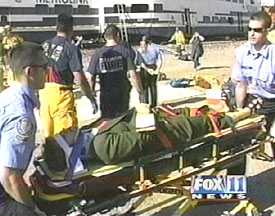


Approximately four times a year, the hospitals and emergency responders in Orange County hold large-scale drills to test the patient triage and transportation procedures that must be followed in the event of a mass casualty incident (MCI). HDSCS is always asked to participate. Hospitals verify procedures for activating us in accordance with their Incident Command System. We test our deployment and net procedures and get an opportunity to practice handling realistic disaster-related traffic. On Tuesday, 23 April 2002, two dozen HDSCS members awaited their assignments for a mock hazardous material incident, to be staged on a shopping street in Brea, California at 9 AM.
But at 8:10 AM, just 5-1/2 miles away in the city of Placentia, a 6000-ton mile-long freight train collided with a Metrolink double-decker commuter train. Three passengers lost their lives and over 200 were injured, many seriously. HDSCS Net Control WA6OPS immediately assigned the drill-ready hams to the fourteen hospitals expected to receive patients from the crash. For the next 4-1/2 hours, a total of 28 HDSCS hams provided vital links between these hospitals, the county's Central Point ambulance dispatch, and the county's Emergency Medical Service agency.
Amateur Radio net messages (traffic) included verifying victim dispatch and patient counts, locating victims prior to completion of the EMS database, providing hospitals with information for inquiring victim families, and liaison with hams supporting the Red Cross. Within some hospitals, hams provided direct communications between triage areas, Emergency Departments, and Command Posts (see photo below). Assistant Coordinator Dennis Kidder WA6NIA explained the importance of internal communications at the hospital where he was assigned: "We were repeatedly told by staff and the hospital Incident Commander how much they appreciated our being there. Early on, their internal communications were in a bit of a turmoil because their own walkie-talkies weren't working, so we provided an immediate backup for them between the Emergency Department and the Command Post, because they were hurting really bad for that."
This was the 75th hospital communications emergency response in the 21-year history of HDSCS. If the Brea drill had taken place, it would have been the 119th time that HDSCS has participated in a drill with hospitals in Orange County.
Name and callsign Responded to
Bruce Chappell KE6TSM UCI Med Ctr
Jean Creason KC6PPY St. Joseph Med Ctr
Sam Creason K6EW Base station
Tom Curlee WB6UZZ Los Alamitos General Hosp
David Daniel KE6NVJ St. Jude Med Ctr
Tom Gaccione WB2LRH UCI Med Ctr
John Gillette N6NVR St. Jude Med Ctr
Ed Green AD6SR Western Med Ctr, Santa Ana
Dennis Kidder WA6NIA St. Jude Med Ctr
Fred Lochner WA6FRA Anaheim General Hosp
April Moell WA6OPS Net Control Station
Dave Mofford W7KTS Base station
Harry Mortimer N6KSC Western Med Ctr, Santa Ana
Dick Schmieter KM6MH Central Point at OC EOC
Mike Scofield N6OKG West Anaheim Med Ctr
Cheryl Simpson KD6MWZ Brea Community Hosp
Ken Simpson W6KOS Central Point at OC EOC
Keith Soesbe WR6R Western Med Ctr, Anaheim
Clay Stearns KE6TZR St. Joseph Med Ctr
Ralph Swanson WB6JBI Anaheim Memorial Med Ctr
George Thompson KD6GQF Brea Community Hosp
Jay Thompson W6JAY Garden Grove Hosp
Richard Thompson WA6NOL Garden Grove Hosp
Fred Wagner KQ6Q UCI Med Ctr
John Walker AC7GK Chapman General Hosp
Al Way KC6LNP Anaheim Memorial Med Ctr
Jack Woolf KF6YQQ Placentia-Linda Hosp
Larry Woolf KF6YCM Kaiser Permanente Hospital, Anaheim
Cheryl Simpson KD6MWZ: "Usually I monitor our net with an earphone, but the hospital Command Post people wanted me to leave the speaker on so that they could listen to our net for additional information."
Larry Woolf KF6YCM: "The hospital looked to the hams for a lot of info and we did not let them down. The fact that we were able to get information quickly impressed them greatly! I think they now really consider us a major component of their response team."
Fred Wagner KQ6Q: "Handling inquiries to locate crash victims/patients are a superb public confidence builder. When a hospital staffer has tried to locate a victim who is a fellow staffer at that hospital, has already tried the established and published methods, comes to the hams, asks for help, and has the victim located in minutes - they know that the hams have their act together, and the word spreads informally."
April Moell WA6OPS: "It was amazing how much this actual communications emergency seemed like 'just another drill' for us. All of our HDSCS operators went to their reassigned hospitals and got onto the net quickly, without having to ask for directions or further instructions. Their message-handling procedures were excellent. Having drilled with our hospitals over a hundred times has paid off well for us and for them."
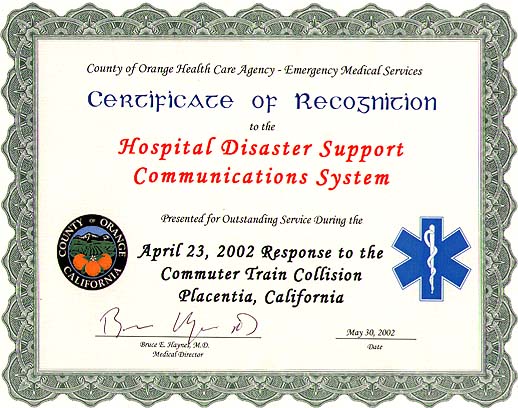
Mary Massey, Pre-Hospital Care Coordinator at Anaheim Memorial Medical Center: "Tell your people what a FANTASTIC job they did for us Tuesday. It is one area that always comes through for us."
Ann Scott, Pre-Hospital Care Coordinator at St. Jude Medical Center: "I got more instantaneous information from my ham operator, so that I was able to prepare. He was right out there -- he was wonderful!"
Marla Gayne, Interim Pre-Hospital Care Coordinator at UCI Medical Center: "Our ham operator was totally invaluable. He provided us with a lot of information that we didn't have access to, so it was really wonderful having him there. He knew what was going on throughout the county and kept us informed about patient dispatches."
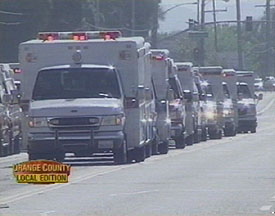
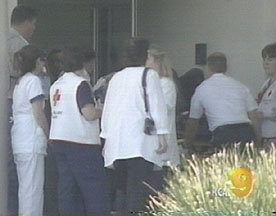
Photos on this page are from local television coverage of the accident. In the photo at right above, HDSCS responder John Gillette N6NVR (far left) stands with his radio at the entrance to St. Jude Medical Center's Emergency Department, providing direct communications to an HDSCS operator at that hospital's Command Post.

Go to the next activation report
Back to the HDSCS News Notes page
Back to the HDSCS home page
This page updated 27 November 2006